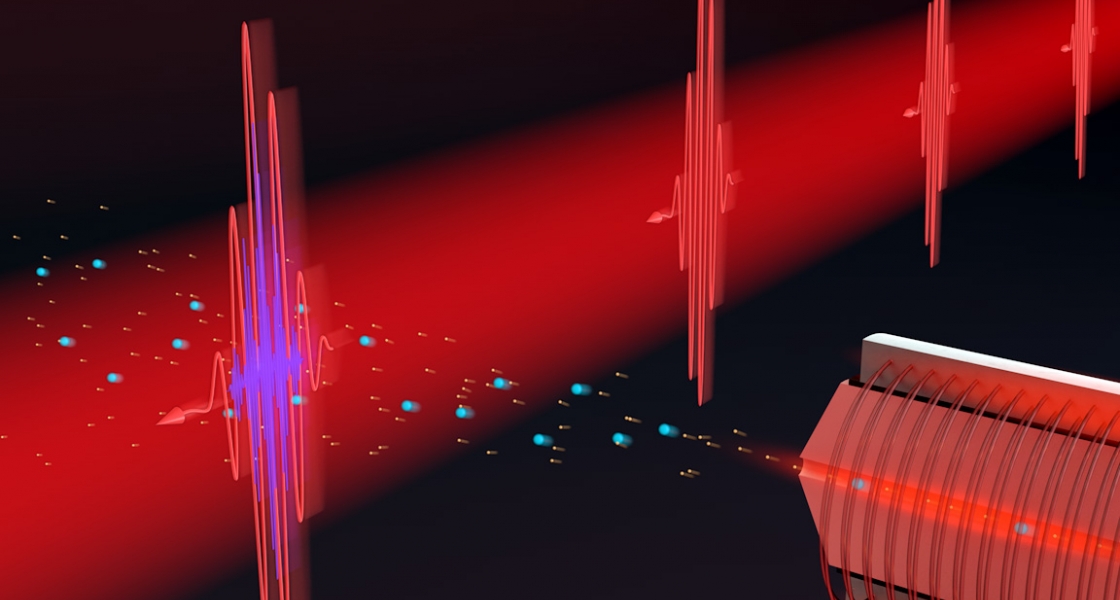With the advent of the laser, the fuzzy bands glowing from atoms transformed into narrow lines of distinct color. These spectral lines became guiding beacons visible from the quantum frontier.
More than a half century later, we stand at the next frontier. The elegant physics that will decode today’s mysteries (such as dark matter, dark energy, and the stability of our fundamental constants, to name a few) is still shrouded in shadows. But a new tool promises illumination.
Whereas the monochrome glow of the laser illumed the mysteries of the quantum frontier, today’s frontier is lit by the frequency comb – a revolutionary laser source that emits not one, but over one-million distinct colors.
“Like the teeth of a comb that you could comb your hair with,” is how Stephen Schoun, a postdoc in the Ye group, describes the comb’s evenly spaced frequency (color) prongs. These prongs act like ticks on a ruler, allowing physicists to measure frequency distances and thus enabling the most precise measurements of atomic and molecular dynamics.
“The idea is to take this highly successful comb concept, which has been applied for years in the infrared and the visible, and now apply it to the extreme ultraviolet,” said Schoun.
Extreme ultraviolet (XUV) is the region of the electromagnetic spectrum between ultraviolet (which travels just deep enough to burn skin) and X-rays (which travels past skin, imaging bones). With an XUV comb, we could potentially probe new atomic structures and observe wobbles in the fine structure constant (the strength of the electromagnetic attraction holding atoms, and therefore most other things, together).
But when transformed into a comb, XUV lacks power.
“It was a major setback for spectroscopy that the power was very low,” said Gil Porat, another Ye group postdoc on the team. “You need enough power to be able to observe the results of spectroscopy precisely.”
Unfortunately, increasing power was not as simple as adding an amplifier. The real problem was pollution – plasma pollution, to be exact.
To generate XUV light, the group must blast Xenon atoms with infrared (IR) light, which lobs away the atoms’ electrons. When the electrons eventually smash back into their parent ion, an XUV photon emerges.
“The problem is most electrons don’t recombine,” explained Porat. “They miss their parent ion, and then you have a lot of electrons flying around their parent ions and not recombining, and that is what we call plasma.”
In standard XUV generation, plasma naturally dissipates. But to translate the bristly “comb structure” from IR to XUV, atoms must be blasted a thousand times more frequently. Lacking adequate time to dissipate, the plasma will accumulate into a thick smog.
Amidst this plasma smog, XUV will dwindle to a weak glow. This dwindling is caused by the same process that separates violet from red within a prism. Travelling at different speeds, the XUV lags behind IR within plasma, and this lag prevents XUV photons from accumulating into a powerful beam (i.e., the interference shifts from constructive to destructive).
To increase XUV power “[we needed] to push the plasma out of the way,” said Porat.
But push quickly turned to shove as the team resolved to remove the plasma by any means necessary. First, they mixed Helium into their gas to make the Xenon atoms squeak across the chamber like a high-pitched balloon voice. But they found this new gas mixture demanded higher pressures, and soon their gas faucet was puffing as hard as an air gun. Finally, the plasma could be pushed even faster with heat, they concurred, as they increased the temperature to near molten lava.
Amid the chaos of speed, heat and pressure “there was a lot of trial and error,” admitted Porat, “we broke a lot of stuff.” Explosions of glass and spews of liquid metal earned top spots on the list of learned lessons, but ultimately the lab survived.




